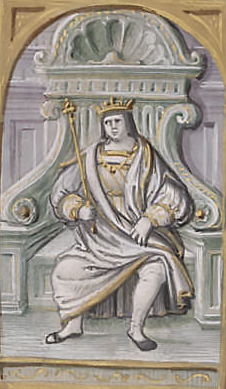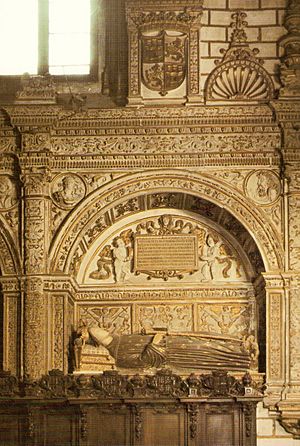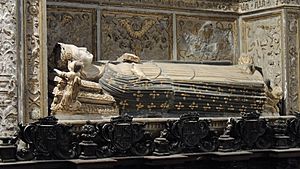Henry III of Castile facts for kids
Quick facts for kids Henry III |
|
|---|---|

Depiction in Alfonso de Cartagena's Liber Genealogiae Regum Hispaniae
|
|
| King of Castile and León | |
| Reign | 9 October 1390 – 25 December 1406 |
| Predecessor | John I |
| Successor | John II |
| Born | 4 October 1379 Burgos |
| Died | 25 December 1406 (aged 27) Toledo |
| Burial | Cathedral of Toledo |
| Spouse | Catherine of Lancaster |
| Issue Detail |
Maria, Queen of Aragon Catherine, Duchess of Villena John II, King of Castile |
| House | Trastámara |
| Father | John I, King of Castile |
| Mother | Eleanor of Aragon |
| Religion | Roman Catholicism |
Henry III of Castile (born October 4, 1379 – died December 25, 1406) was a king of Castile. People called him "the Suffering" because he was often sick. He was the son of King John I and Queen Eleanor of Aragon. Henry became King of Castile in 1390 after his father passed away.
Contents
Early Life and Education
Henry was born in Burgos, which was the capital city of Castile. He was the first child of King John I and Queen Eleanor. His younger brother, Ferdinand, later became the King of Aragon.
When Henry was a child, Inés Lasso de la Vega helped raise him. His teacher was Diego de Anaya Maldonado, a bishop who later became an archbishop. Juan Hurtado de Mendoza was his tutor, and Alonso de Cusanza was his confessor.
Becoming Prince of Asturias
When Henry was getting married, he received the special title of Prince of Asturias. This title meant he was the heir apparent, or the next in line to become king. He was the very first person to hold this title. Before him, heirs to the throne were simply called infantes mayores.
In 1390, Henry's father, King John I, thought about giving up his throne to Henry. This was to try and get the Portuguese to accept Henry as king. However, his advisors told him not to, because similar choices had caused problems before. But in October of that same year, King John I died after falling off his horse. So, Henry became king.
Henry officially took power on August 2, 1393. He was only 13 years old. This was a time of many changes in how the kingdom was being run.
Henry III's Reign
Even though Henry III was known as "the Suffering" because of his health, he was a very active king. He worked hard to make Castile strong again. He managed to bring peace among the powerful noble families and made the king's power stronger.
King Henry III had the support of the important noble families. He removed some of the most powerful relatives who had too much influence. He also took away special rights that earlier kings had given to some people. For example, he ended some heavy sales taxes and the right to attend the king's council.
He also made the kingdom's economy better and increased the number of city officials. Henry III tried to protect the Jewish people and passed laws against violence, which had been very bad around 1391.
Military Successes
During Henry's time as king, the Castilian navy won many battles against the English fleet. In 1400, Henry III sent ships to destroy Tétouan in North Africa, which was a base for pirates.
In 1402, he started the colonisation of the Canary Islands. He sent a French explorer named Jean de Béthencourt to begin this project. In 1396, he stopped an invasion by Portugal by attacking Badajoz. He then signed a peace treaty with the King of Portugal on August 15, 1402.
Diplomatic Efforts
Henry III also sent important people like Payo Gómez de Sotomayor and Hernán Sánchez de Palazuelos as ambassadors. Later, on May 21, 1403, he sent Ruy González de Clavijo to meet with Timur, a powerful ruler. They wanted to talk about a possible alliance between Castile and the Timurid Empire against the Ottoman Empire. Ruy González de Clavijo wrote a book about his travels called Embajada a Tamorlán.
Henry III supported Antipope Benedict XIII, who claimed to be the true Pope. He also restarted the fight against the kingdom of Granada. Castile won an important battle at Battle of Collejares, near Úbeda, in 1406. This victory helped free the town. However, Henry's death later that year stopped him from finishing this campaign.
In 1406, King Henry built a hunting lodge on Mount El Pardo. It was a good place for hunting because there was a lot of game there. Later, Charles V, Holy Roman Emperor changed this lodge into the Royal Palace of El Pardo.
Because of his poor health, King Henry III gave some of his power to his brother, King Ferdinand I of Aragon. Ferdinand became the regent, meaning he ruled for Henry's young son, John II of Castile, who was too young to be king.
King Henry III died in the city of Toledo on December 25, 1406. He was getting ready for another campaign against the Emirate of Granada when he passed away.
Royal Tomb
After Henry's death, his body was taken to Toledo. He was buried in a special tomb in the Chapel of the New Monarchs inside the Cathedral of Toledo. His remains are still there today.
His tomb is made in the Plateresque style. It has the shields of Castile and León on it. There is a statue of Henry III on top of the tomb. The statue shows him wearing a Franciscan robe, with his hands holding his sword. His head, wearing a crown, rests on three cushions, and his feet are bare. Four angels kneel at the corners of the statue.
An inscription on the tomb, written in old Spanish, says: "Here lies the much feared and righteous king Henry, of sweet memory, may God [give him] the Holy Paradise, [he was] son of the Catholic King John I and grandson of the noble knight Henry. In the 16 years he reigned, Castile was feared and honored. [He] was born in Burgos on the day of St Francis and died on Christmas Day in Toledo, going to war against the Moors with the kingdom's nobles, finishing AD 1407."
Marriage and Children
Soon after Henry was born, he was promised to marry Beatrice of Portugal. She was the heir to the Portuguese throne. This was part of a peace treaty between Castile and Portugal. However, this marriage did not happen. Instead, Beatrice married Henry's father, which led to a war for the throne with John of Aviz.
On September 17, 1388, Henry married Catherine of Lancaster (1372–1418). This marriage was part of the Treaty of Bayonne. Catherine was the daughter of John of Gaunt, 1st Duke of Lancaster, and Constance of Castile. Constance was the older daughter of King Peter. This marriage helped end a long family conflict and made the House of Trastámara stronger.
Their wedding took place in Palencia Cathedral. Henry and Catherine had three children:
- Maria (1401–1458), who became the wife of Alfonso V of Aragon and Queen of Aragon.
- Catherine (1403–1439), who married Infante Henry, Duke of Villena.
- John II (1405–1454), who became King of Castile after his father.
See also
 In Spanish: Enrique III de Castilla para niños
In Spanish: Enrique III de Castilla para niños



